The Galapagos Islands are a haven for marine life, including some of the world's most fascinating and impressive shark species. From the gracefully floating whale shark to the distinctive hammerhead shark, these creatures have captured the imagination of travelers and marine biologists alike. In the following article, we'll be examining some of the notable and sizable shark species discovered in the Galapagos Islands. While there are more than 30 distinct types of sharks inhabiting the region, we'll be focusing on the most prevalent species.
Learn more about these incredible shark species and how we are working to protect these majestic creatures

Scalloped Hammerhead Sharks
These unusual-looking sharks get their name from their distinctive head shape, which resembles a hammer.
Like all hammerhead sharks, the scalloped hammerhead is an active predator and gains several advantages from the shape of its head. The widely spaced eyes, nostrils, and other senses allow the
scalloped hammerhead to more successfully locate its prey near, or buried in, the sea floor. These sharks are known to eat a large range of prey, such as fish (including other sharks), squid,
octopus, and crustaceans. Stingrays are a particular favorite. Like most sharks, the scalloped hammerhead has special sensory cells that it can use to detect the electric field given off by all
other fishes. The wide head likely allows this species to more accurately utilize this sense, helping it to locate prey buried in the sand.
Scientists are unsure why scalloped hammerheads form occasional large groups, while maintaining solitary lifestyles for much of the time in between, but they seem to be social animals for at
least part of the year. The scalloped hammerhead shark is listed as endangered.
In the Galapagos Islands the best time to dive with big schools of hammerhead sharks is June to November.
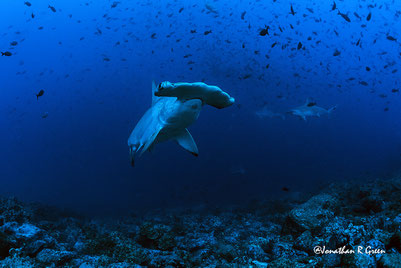
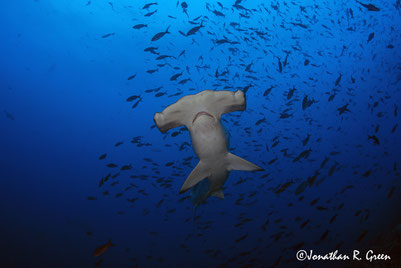
Whale Sharks
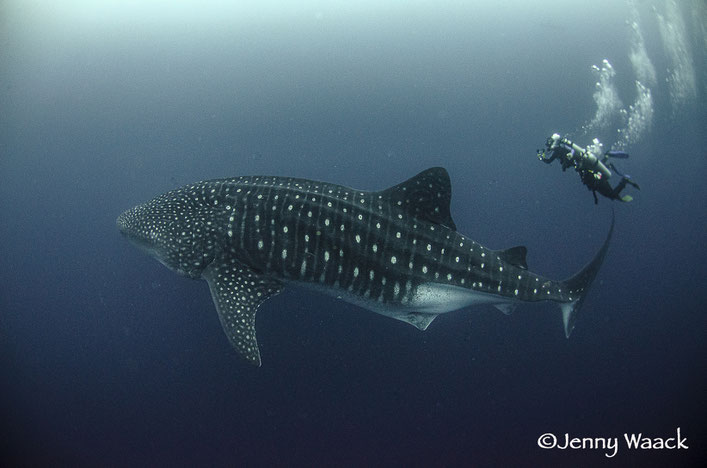
In the Galapagos, you can dive with the mightiest of all sharks… the Whale Shark! Whale sharks can be up to 15 meters / 45 feet in length and weigh on average of 25 tons (bigger than an average school bus). Whale sharks are NOT mammals - they do not breathe air. The name “whale” refers simply to their size. It is the world’s largest fish and the biggest shark ever to exist.
Despite their size, whale sharks are gentle giants that feed on plankton, small fish, and other tiny creatures. Whale Sharks are filter feeders! Being a filter feeder, whale sharks cannot bit nor chew. Instead of biting and chewing, they mostly sieve plankton through their gills for nourishment. During feeding their mouth can even stretch over 1 meter/4 feet wide! Even though whale sharks feed on some of the smallest beings of the ocean by filtering them through their gills, they have around 300 rows of tiny teeth? These are believed to be vestigial structures, meaning they no longer serve a purpose. However, these sharks also have what may seem like tiny teeth (more appropriately dermal denticles) around their eyes. These do have a purpose and seem to serve to protect the eye of the whale shark. Evidencing that eyesight might be more important to these animals than was previously believed. Whale sharks are fish, NOT whales, as many people believe.
Galapagos is the only place in the world where 99.8% of the whale sharks are truly HUGE adult females. They are “ovoviviparous” meaning the young hatch from eggs, as with all fish, but the incubation is internal and the young are born alive. The babies are born free-swimming at 40-60 cm long, and likely get no further assistance from their mother. Almost nothing is known about whale shark reproduction. Only one pregnant female has ever been examined by scientists. This female whale shark was caught in a fishery in Taiwan in 1995. Incredibly, this singular female was carrying 304 tiny whale shark babies/embryos. Some were up to 64 cm long. Other than that, we know little about whale shark reproduction (Simon J Pierce).
Did you know that whale sharks dive deeper than 2000 meters! How deep - nobody knows! There are many things we still don't know about this gentle giants! The global whale shark population has been declared endangered by the IUCN, with their main threat being fisheries, bycatch losses and demand for shark fins, liver oil, skin and meat. In order to protect them we need to know more about them which is why Galapagos Shark Diving is proud to support marine conservation in the Galapagos Islands by donating all profits to the Galapagos Whale Shark Project. This project focuses on tracking the migration patterns and dive behaviors of whale sharks, so we can better protect these majestic creatures and their habitats.
In the Galapagos Islands, whale sharks are often seen in the warm waters near Darwin and Wolf Islands. Divers can swim alongside these magnificent creatures, making for a truly unforgettable experience. The best time of year to see Whale Sharks is between June and October. Check out our blog post about the best the Best Time of Year to Scuba Dive in the Galapagos Islands.
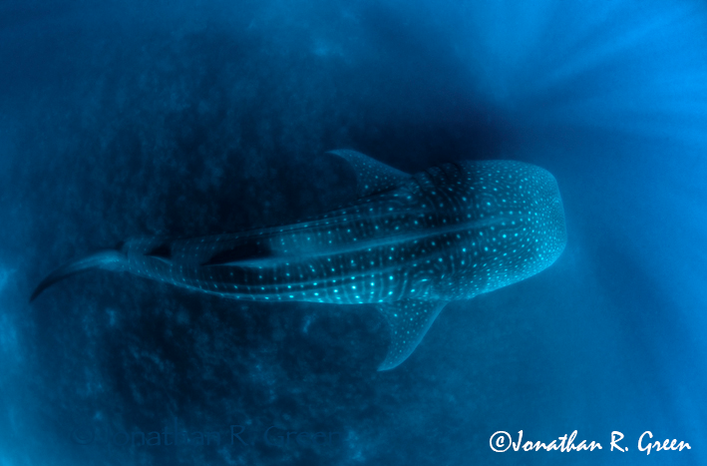
Galapagos Sharks
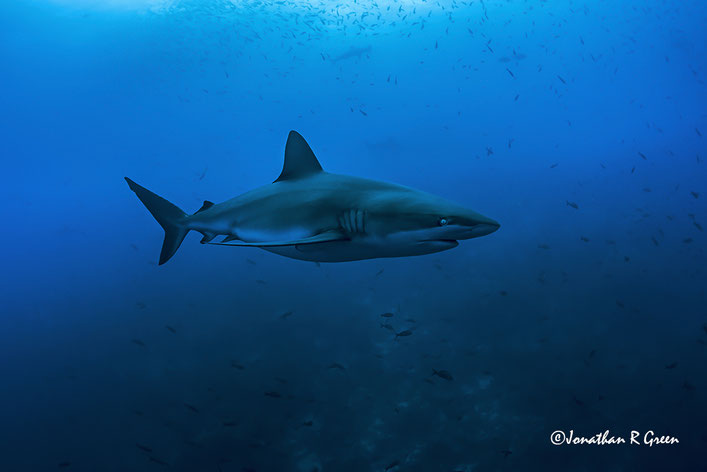
The Galapagos shark is found all over the world, but it was first discovered in what is now the Galapagos Marine Reserve.
They can be be seen throughout the year around the Galapagos Islands. In Galapagos, they are particularly seen in the waters off of Wolf and Darwin islands. Their mating season is between January and March so juvenile sharks may be seen in the shallow waters along the coastline until about April.
Information: https://galapagosconservation.org.uk/wildlife/galapagos-shark/
Tiger Sharks
Tiger sharks are named for the dark, vertical stripes found mainly on juveniles. As these sharks mature, the lines begin to fade and almost disappear. These sharks are known for their
powerful jaws and sharp teeth. Tiger sharks are typically found in deeper waters, and they feed on a wide variety of prey, including seals, sea turtles, and other large fish. In the Galapagos
Islands, tiger sharks are seen infrequently, but they are known to patrol the waters near the Darwin and Wolf Islands.
Information: https://www.nationalgeographic.com/animals/fish/facts/tiger-shark
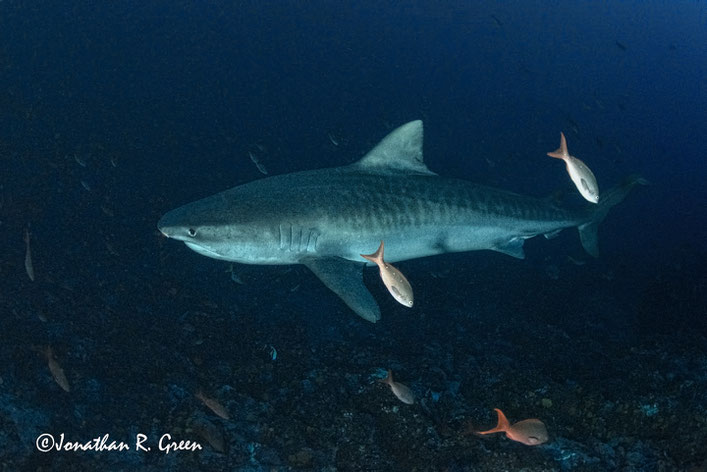
Blacktip Reef Sharks
These small, sharks are known for their distinctive black-tipped fins. Blacktip reef sharks are most frequently seen in Galapagos across the numerous reefs around the Archipelago, where their main food source is plentiful, but young sharks use mangroves as their nurseries.
They prefers warm, shallow coastal waters and estuaries as opposed to the deep open ocean. The shark usually gives birth to four-six pups in each litter, and the Galapagos Marine Reserve provides important sites for their pupping grounds. Fish make up 90% of their diet, but they will also feed on rays, skates and smaller sharks.
Information: https://galapagosconservation.org.uk/wildlife/blacktip-shark/
Did you know: Blacktip sharks are known to make spinning leaps out of the water while attacking schools of small fish. This dramatic display is sometimes part of their feeding method.
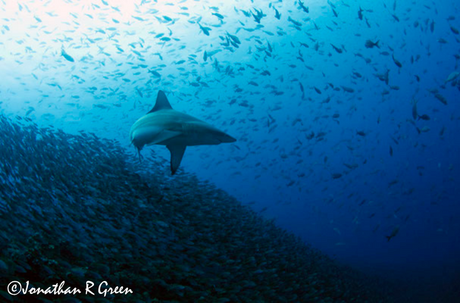
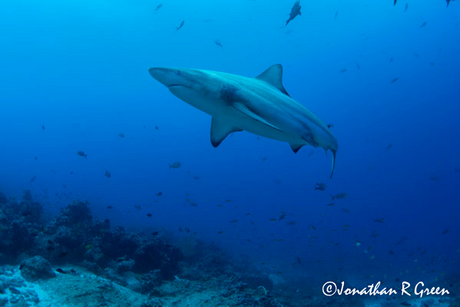
Silky Sharks
Silky sharks are smooth, sleek oceanic predators with densely packed dermal denticles that give their skin a distinct sheen. They live in the open ocean but are often found around seamounts, where schooling in their hundreds can be seen. Silky sharks were once one of the most abundant shark species in the ocean but are now unfortunately the second most sought-after shark species globally and one of the most commonly traded species in shark fin markets.
At first, silky sharks can seem difficult to identify as they lack clearly distinguishing markings. They are large and slender with a grey/bronze color and are often mistaken for Galapagos sharks.
The easiest way to recognize silky sharks and tell these two species apart is by their first dorsal fin:
Silky sharks - have a sloped dorsal fin with quite a rounded tip
Galapagos sharks - have a steep dorsal fin with a pointed tip and straight rear edge
These sharks are highly curious and are regularly encountered by photographers due to their curiosity and close approaches in the Galapagos.
Information: https://saveourseas.com/worldofsharks/species/silky-shark
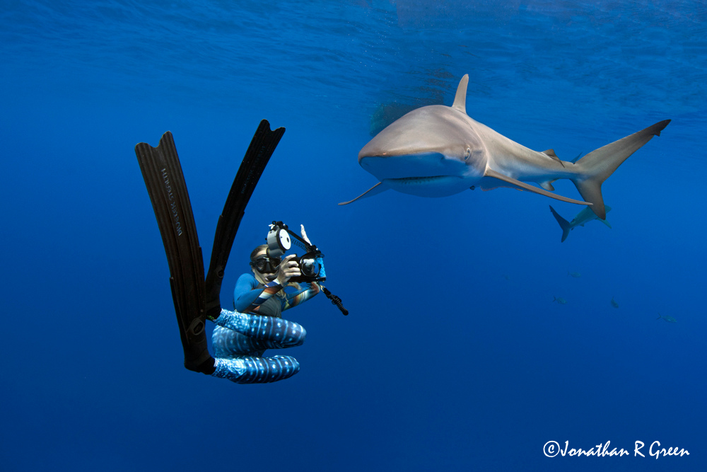
Whitetip Reef Sharks
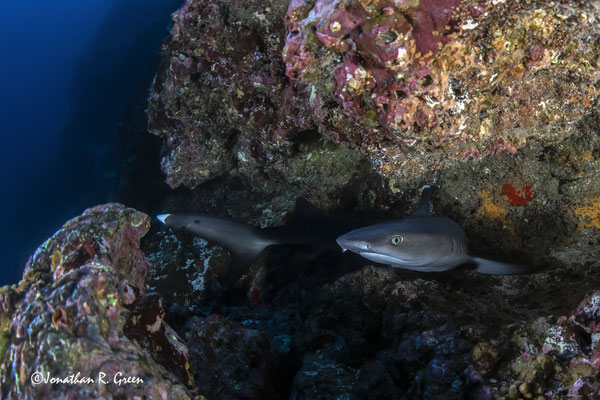
The whitetip reef sharks are small to medium in size and the plentiful supply of food in Galapagos means the whitetip reef shark is a passive creature. Unlike the blacktip shark, which have black marks on the end of their fins, the whitetip have white marks.
During the day, many sharks crowd into caves, often stacking themselves on top of each other. Whitetips normally return to the same cave or crevice every day, sometimes for years. During the night they hunt smaller reef creatures that are hidden in the coral.
Whitetip reef sharks are one of the most abundant Galapagos reef sharks. The species can be spotted throughout the entire Archipelago, but are most often seen around North Seymour, Champion and Gardner islets, and northern Isabela island. This shark is active at all times of the year so your chances of seeing one is very high!
Information: https://galapagosconservation.org.uk/wildlife/whitetip-reef-shark/
Galapagos Bullhead Sharks

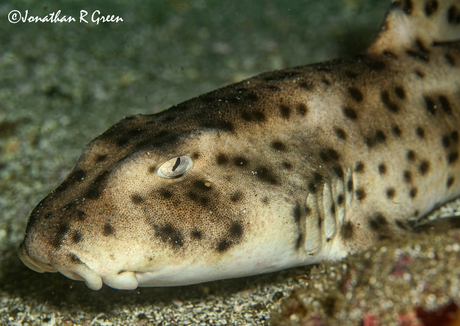
"Since its discovery 175 years ago, the Galapagos bullhead shark has been almost ‘forgotten’ from science. So little is known about the species the IUCN have assessed it as ‘Data Deficient’." -Galapagos Conservation Trust
The Galapagos bullhead shark is a small, bottom-dwelling shark that has been present on earth since the early Jurassic period. It is thought to grow up to 107cm (~3.5 feet) long and live in flat, rocky and boulder strewn reef areas. The species can be found around the Galapagos Archipelago and expands along the Peruvian coast. They can be found resting motionlessly on the ocean floor at the Punte Vicente Roca dive site in the Galapagos.
To find out more about the project visit https://galapagosconservation.org.uk/projects/galapagos-bullhead-shark/
Information: https://galapagosconservation.org.uk/projects/galapagos-bullhead-shark/
In conclusion, the Galapagos Islands are a true paradise for shark lovers, offering a chance to see some of the world's most impressive and fascinating shark species in their natural habitat. Joining a dive liveaboard to the Galapagos Islands is an experience that you will never forget. So why wait? Book your trip today and get ready to discover the fascinating world of sharks in the Galapagos Islands!
Come Aboard and join one of our upcoming trips or get some more information about the Shark Conservation Dive Liveaboards. Looking forward to diving with you soon!









Write a comment